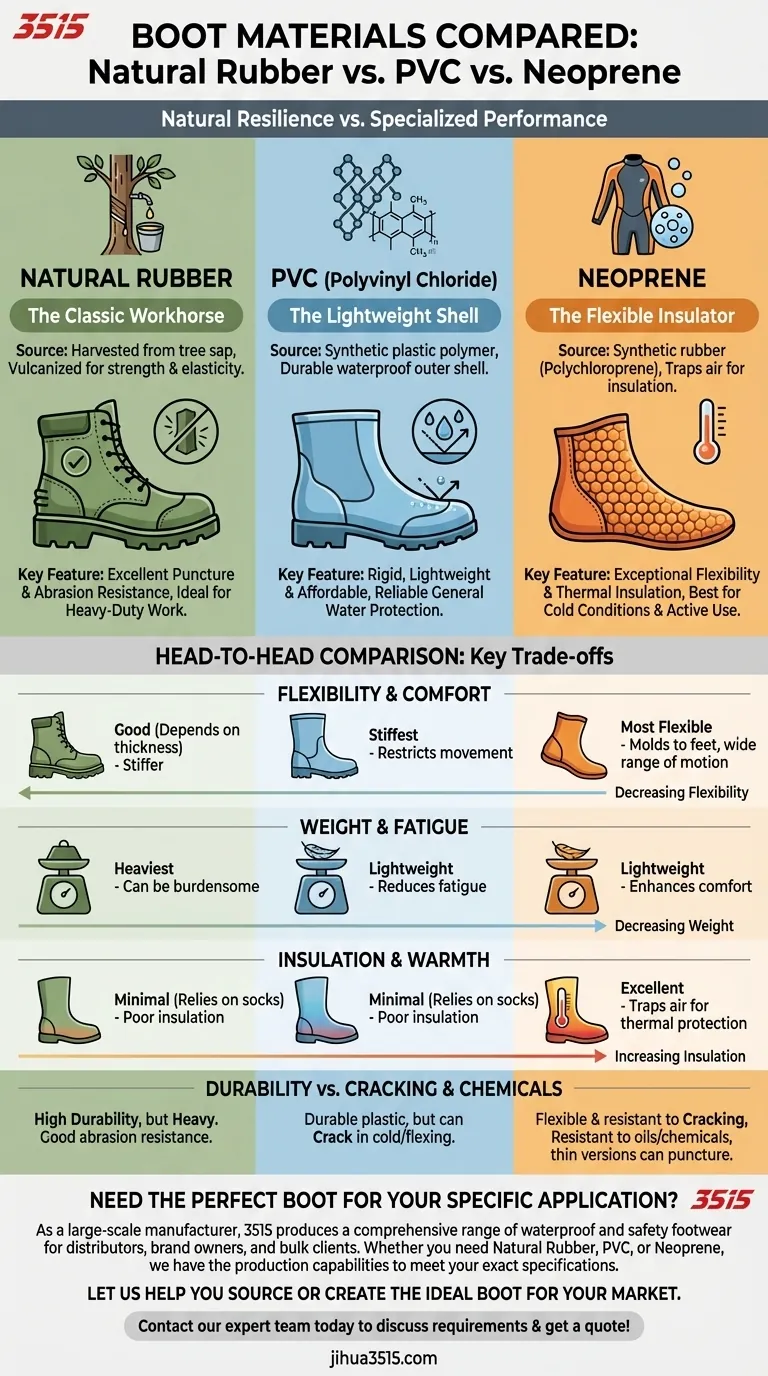At its core, the difference between these boot materials is a choice between natural resilience and specialized synthetic performance. Natural rubber, derived from tree sap, is known for its classic durability, while synthetic materials like PVC and Neoprene are engineered to offer specific advantages like lower weight, superior flexibility, or enhanced insulation.
The choice isn't about which material is universally "better," but which one possesses the specific properties that align with your environment and activity. It's a fundamental trade-off between the rugged, heavy durability of natural rubber and the lightweight, specialized comfort of synthetics.

The Core Difference: Natural vs. Synthetic
Understanding the origin of these materials is the first step to appreciating their distinct characteristics in footwear.
Natural Rubber: The Classic Workhorse
Natural rubber is a raw material harvested from the sap of rubber trees. This natural polymer is then vulcanized—a process of heating it with sulfur—to vastly improve its strength, elasticity, and waterproof properties, making it an excellent material for rugged boots.
PVC: The Lightweight Shell
Polyvinyl Chloride (PVC) is a widely used synthetic plastic polymer. In boots, it provides a completely waterproof and durable outer shell. It is generally more rigid than rubber and is valued for being lightweight and affordable.
Neoprene: The Flexible Insulator
Neoprene is a synthetic rubber made from polychloroprene. While also waterproof, its primary advantages are exceptional flexibility and insulation. It is often used as a bootie or lining inside a more rigid shell to provide warmth and a comfortable, form-fitting feel.
A Head-to-Head Functional Comparison
While all three materials provide excellent waterproofing, they diverge significantly in comfort, weight, and thermal performance.
Flexibility and Comfort
Neoprene is the most flexible of the three, easily molding to the shape of your feet and calves for a snug, personalized fit that allows for a wide range of motion.
Natural rubber offers good flexibility, but this is highly dependent on the thickness of the material. Thicker, more durable rubber boots will be inherently stiffer.
PVC is the stiffest material, providing more structure but restricting ankle and foot movement the most.
Weight and Fatigue
PVC and Neoprene boots are significantly lighter than their rubber counterparts. This reduced weight can make a major difference in comfort and fatigue over a long day of walking or standing.
Natural rubber boots are typically the heaviest, especially those with thick, heavy-duty construction. This weight provides a sense of ruggedness but can become burdensome during prolonged use.
Insulation and Warmth
Neoprene is the clear winner for insulation. Its cellular structure traps air, providing excellent thermal protection that makes it ideal for use in cold water or chilly weather conditions.
Natural rubber and PVC offer minimal insulation on their own. Boots made from these materials rely on the thickness of the material and the user's socks for warmth.
Understanding the Trade-offs
Choosing the right material means being honest about its limitations and how they apply to your needs.
Durability vs. Cracking
Natural rubber is known for its excellent puncture and abrasion resistance, making it ideal for harsh, rugged work environments. However, it is heavy.
PVC is a durable plastic, but its rigidity can become a liability. In very cold temperatures or after repeated flexing, it can be more prone to cracking than flexible rubber.
Neoprene's flexibility makes it highly resistant to cracking from movement, but a thin neoprene bootie may be more susceptible to punctures than a thick rubber shell. This is why it is often paired with a rubber or PVC outer.
Chemical Resistance
Each material reacts differently to chemicals, which is a critical consideration in some work environments. Neoprene, for example, is well-regarded for its resistance to oils and a range of chemicals, a property not always shared by natural rubber.
Making the Right Choice for Your Goal
Select your boot material based on the most demanding aspect of your intended use.
- If your primary focus is maximum durability for heavy-duty work: Choose a thick natural rubber boot for its superior resistance to punctures and abrasion.
- If your primary focus is warmth and flexibility for active use in cold conditions: Choose a Neoprene boot that provides both insulation and a comfortable, non-restrictive fit.
- If your primary focus is a lightweight, waterproof, and affordable option for general tasks: A PVC boot offers reliable water protection without the weight or cost of natural rubber.
Understanding these material trade-offs empowers you to select a boot that functions as a true tool for the job.
Summary Table:
| Feature | Natural Rubber | PVC | Neoprene |
|---|---|---|---|
| Flexibility | Good (depends on thickness) | Stiffest | Most Flexible |
| Weight | Heaviest | Lightweight | Lightweight |
| Insulation | Minimal (relies on socks) | Minimal | Excellent |
| Durability | Excellent puncture/abrasion resistance | Durable, but can crack in cold | Flexible, but thin versions can puncture |
| Best For | Heavy-duty, rugged work | Lightweight, affordable, general use | Cold conditions, active use, flexibility |
Need the Perfect Boot for Your Specific Application?
As a large-scale manufacturer, 3515 produces a comprehensive range of waterproof and safety footwear for distributors, brand owners, and bulk clients. Whether your customers need the rugged durability of natural rubber, the lightweight affordability of PVC, or the insulated flexibility of Neoprene, we have the production capabilities to meet your exact specifications.
Let us help you source or create the ideal boot for your market.
Contact our expert team today to discuss your requirements and get a quote!
Visual Guide

Related Products
- Safety Footwear Wholesale Manufacturer for Custom OEM/ODM Production
- Premium Flame-Retardant Waterproof Safety Boots and Shoes
- Wholesale Safety Footwear Manufacturer for Bulk & Custom OEM Orders
- Wholesale Waterproof Tactical Boots Custom Suede & High-Traction Soles
- Factory Direct Wholesale Rain Boots Durable Waterproof & Fully Customizable
People Also Ask
- How do safety shoes contribute to cost savings for companies? A Strategic Investment in Risk and Cost Management
- Is it normal to wear shoes in the house? A Guide to Hygiene, Comfort & Culture
- How long can you wear safety boots? The Lifespan is Determined by Wear, Not Time
- Do snake bite boots work? Your Ultimate Guide to Effective Snake Bite Protection
- What do heavy duty boots do? Protect Your Feet in Demanding Work Environments



















